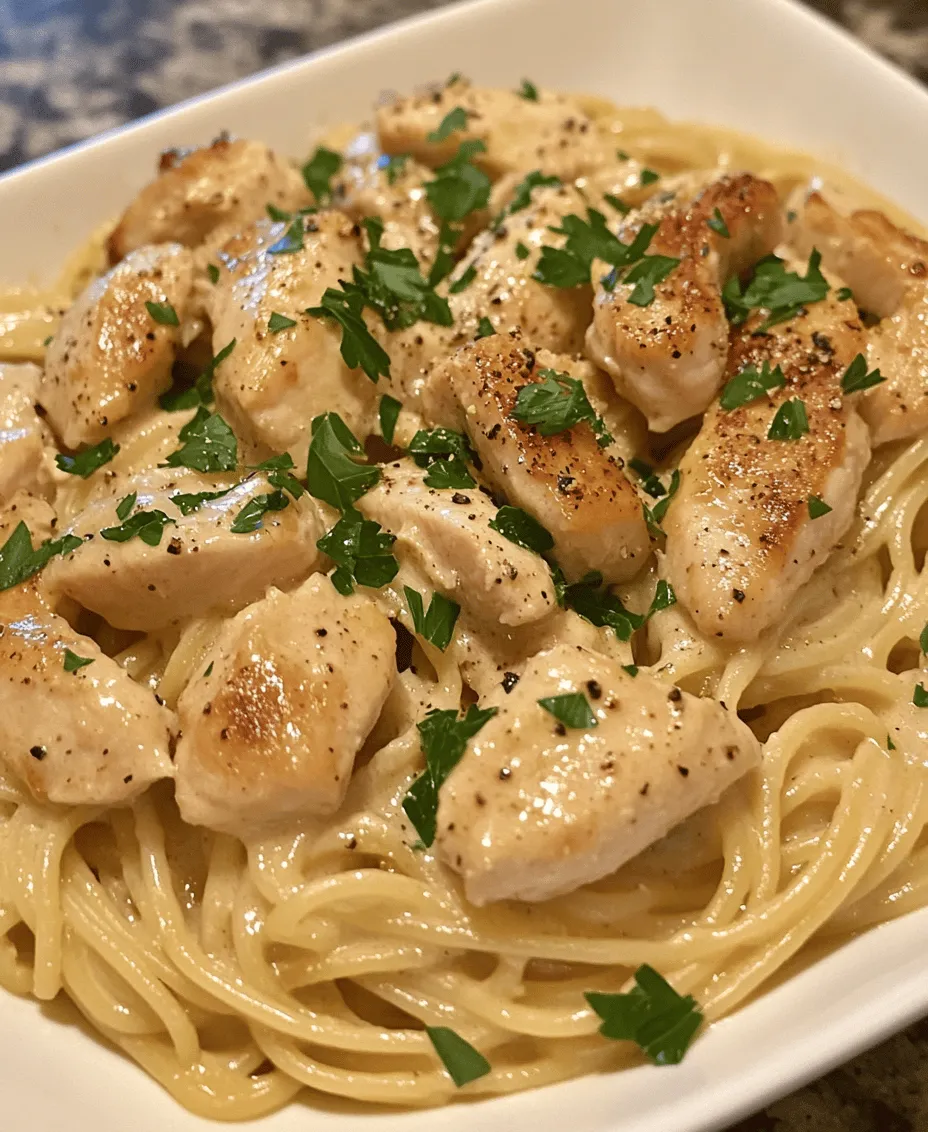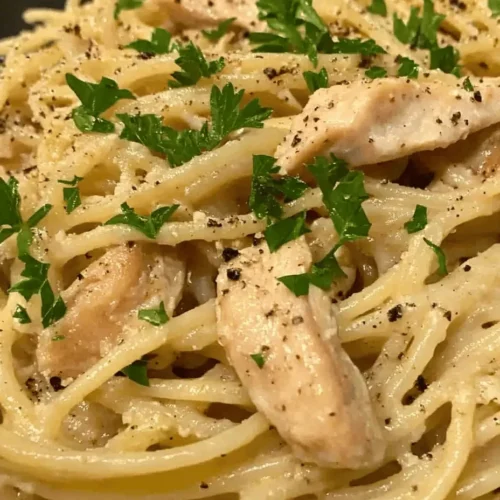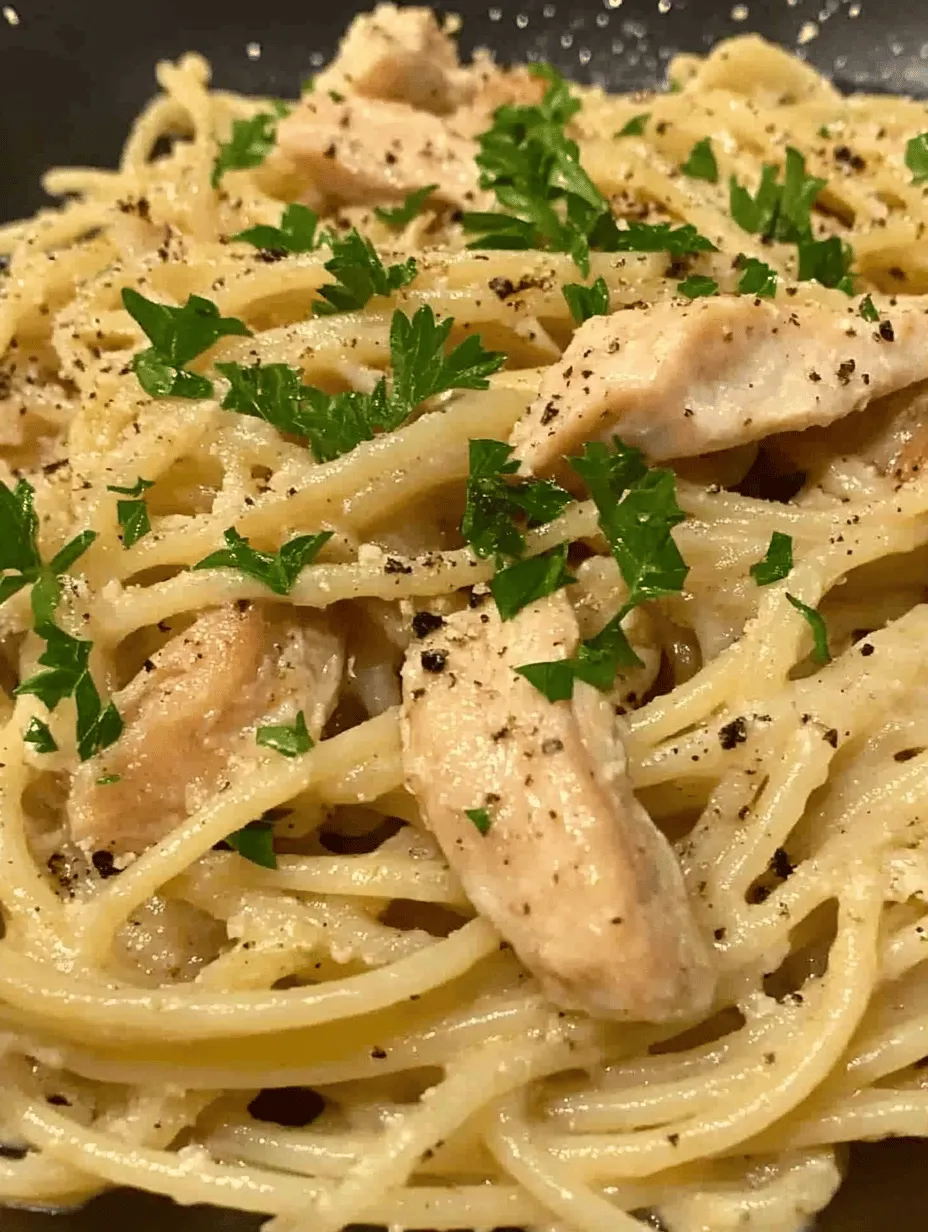Introduction
Italian cuisine is celebrated worldwide for its rich flavors and comforting dishes, and one of the standout offerings is Carbonara. This classic pasta dish, originating from the heart of Rome, is known for its creamy texture and savory ingredients. Traditionally, Carbonara is made with a base of eggs, cheese, pancetta, and black pepper, tossed together with pasta to create a luscious sauce that clings to each strand. However, for those seeking a more substantial meal, incorporating chicken into the recipe offers a delightful twist that transforms the dish into a satisfying main course.
The Best-Ever Chicken Carbonara is perfect for family dinners or entertaining guests, as it brings together the comfort of traditional Carbonara with the added protein of chicken. Its hearty nature makes it an ideal choice for those who want to enjoy a rich, flavorful meal that feels indulgent yet approachable. In this article, we’ll delve into the origins of Carbonara, explore the essential ingredients, and provide detailed cooking instructions to help you create this delicious dish at home.
Understanding Carbonara
Carbonara has a storied history rooted in Roman cuisine. The dish is believed to have originated in the mid-20th century, although its exact beginnings are shrouded in mystery. Some theories suggest that it was created by Italian charcoal workers (“carbonai” in Italian), who would bring simple ingredients to cook over a fire. Others claim that it was influenced by American soldiers stationed in Italy during World War II, who introduced ingredients like bacon and eggs to the local cuisine.
Traditional Carbonara is defined by its simplicity, using just a handful of high-quality ingredients to create a rich and satisfying meal. The foundational elements include pasta (usually spaghetti or fettuccine), eggs, cheese (typically Pecorino Romano), and cured pork (pancetta or guanciale). The technique involves gently mixing the hot pasta with the egg and cheese mixture, allowing the residual heat to create a creamy sauce without scrambling the eggs.
Over time, variations of Carbonara have emerged, with many home cooks and chefs experimenting with different ingredients to suit personal tastes. One popular adaptation is the addition of chicken, which adds a heartiness to the dish and makes it more filling. By incorporating chicken, the Best-Ever Chicken Carbonara becomes not only a tribute to the classic recipe but also a versatile dish that can please a crowd.
Ingredients Breakdown
To prepare the Best-Ever Chicken Carbonara, you’ll need the following ingredients, each playing a crucial role in creating the final dish.
Pasta: Spaghetti or Fettuccine
The choice of pasta is fundamental to any Carbonara recipe. Spaghetti is the traditional option, known for its long, thin strands that hold sauce beautifully. However, fettuccine, with its broader and flatter shape, is also a great choice for Carbonara, as it captures the creamy sauce well. When selecting pasta, opt for high-quality, durum wheat pasta, as it will maintain its texture during cooking and offer a satisfying bite.
Chicken Breasts
For the Best-Ever Chicken Carbonara, boneless, skinless chicken breasts are the ideal choice. They are lean, easy to cook, and absorb flavors well. When preparing chicken, choose fresh, high-quality meat for the best results. To enhance the flavor, consider marinating the chicken briefly in olive oil, garlic, and herbs before cooking. This step adds depth to the overall dish and ensures that the chicken remains juicy and tender.
Pancetta or Bacon
Pancetta, a type of Italian cured pork, is the traditional choice for Carbonara, offering a rich, savory flavor. If you cannot find pancetta, bacon serves as a suitable substitute, providing a smoky flavor that complements the creaminess of the sauce. Regardless of the choice, ensure that the pork is cooked until crispy, as this texture adds an essential crunch to the otherwise soft components of the dish.
Eggs
At the heart of Carbonara lies the egg, which acts as the primary sauce. The best results come from using the freshest eggs available. When combined with cheese, the eggs create a creamy and velvety sauce that clings to the pasta. As you mix the hot pasta with the egg mixture, the heat will gently cook the eggs, thickening them without scrambling. For an extra indulgent touch, consider using a combination of whole eggs and egg yolks.
Parmesan Cheese
While traditional Carbonara often calls for Pecorino Romano cheese, using freshly grated Parmesan adds a slightly different flavor profile that many enjoy. The key is to choose high-quality cheese, as it significantly impacts the dish’s overall taste. Freshly grating the cheese ensures that it melts smoothly into the sauce, creating that signature creamy texture.
Garlic
Garlic is an aromatic ingredient that enhances the flavor profile of the dish. While traditional Carbonara does not typically include garlic, adding a clove or two can elevate the overall taste. Sautéing minced garlic in olive oil before cooking the chicken infuses the entire dish with a wonderful aroma and depth of flavor.
Heavy Cream
A defining characteristic of the Best-Ever Chicken Carbonara is its creamy sauce. While traditional recipes often rely solely on eggs and cheese for creaminess, incorporating a bit of heavy cream can enhance the texture and richness of the sauce. If you prefer a lighter version, consider using half-and-half or even a non-dairy cream alternative.
Seasonings
Finally, seasonings such as salt, pepper, and fresh herbs play a vital role in bringing the dish together. Use high-quality sea salt and freshly cracked black pepper to season the pasta and chicken. For an added touch of freshness, consider garnishing the finished dish with chopped parsley or basil.
Preparing the Best-Ever Chicken Carbonara
Now that you have a clear understanding of the ingredients, let’s dive into the step-by-step instructions for preparing the Best-Ever Chicken Carbonara. Follow these detailed steps to create a dish that is sure to impress.
Step 1: Cooking the Pasta
Start by bringing a large pot of salted water to a boil. The water should be salty enough to season the pasta, as it enhances the overall flavor of the dish. Once boiling, add the spaghetti or fettuccine and cook according to the package instructions until al dente. It’s essential to avoid overcooking the pasta, as it will continue to cook when mixed with the sauce.
Before draining the pasta, reserve about a cup of the pasta water. This starchy water will be instrumental in adjusting the sauce’s consistency later on. Drain the pasta and set it aside, keeping it warm while you prepare the remaining ingredients.
Step 2: Cooking the Chicken
While the pasta is cooking, heat a large skillet over medium heat and add a drizzle of olive oil. Season the chicken breasts with salt and pepper, then place them in the skillet. Cook them for about 5-7 minutes on each side, or until they are golden brown and cooked through. The chicken should be tender and juicy, with an internal temperature of 165°F (75°C).
Once cooked, remove the chicken from the skillet and let it rest for a few minutes before slicing it into bite-sized pieces. This resting period allows the juices to redistribute, ensuring that the chicken remains moist and flavorful.
Step 3: Combining Ingredients
In the same skillet used for the chicken, add the chopped pancetta or bacon and cook until crispy. The rendered fat will create a flavorful base for the sauce. If using garlic, add it to the skillet once the meat is crispy, and sauté for about 30 seconds, being careful not to burn it.
Next, return the chicken to the skillet, tossing it with the pancetta and garlic. This step infuses the chicken with savory flavors, enhancing the overall taste of the dish.
Step 4: Creating the Sauce
In a mixing bowl, whisk together the eggs, cheese, and heavy cream, if using. Season with salt and freshly cracked black pepper. Once the pasta is ready and still hot, add it to the skillet with the chicken and pancetta. Quickly pour the egg and cheese mixture over the pasta, tossing everything together vigorously. The heat from the pasta will cook the eggs, creating a creamy sauce that coats each strand.
If the sauce appears too thick, gradually add the reserved pasta water, a few tablespoons at a time, until you reach your desired consistency. The result should be a rich, creamy sauce that clings to the pasta without being overly runny.
Step 5: Serving
Once everything is combined, serve the Best-Ever Chicken Carbonara immediately, garnished with additional grated cheese and freshly chopped herbs if desired. Enjoy the comforting flavors and creamy texture of this hearty dish, perfect for any occasion.
The Best-Ever Chicken Carbonara is a delightful fusion of traditional Italian flavors and hearty chicken, making it a beloved recipe for family gatherings or special dinners. With its rich history and comforting appeal, this dish is sure to become a favorite in your kitchen.

Crisping the Pancetta: Balancing Fat and Flavor in the Dish
The first step in achieving the best-ever Chicken Carbonara is expertly crisping the pancetta. This Italian delicacy, a type of cured pork, is essential for imparting rich flavor and a satisfying texture to the dish. Start by placing diced pancetta in a large skillet over medium heat. The fat from the pancetta will render as it cooks, creating a flavorful base for your sauce.
As the pancetta sizzles, stirring occasionally, keep an eye on the heat. You want it to become golden and crispy, but not burnt. This process should take about 5 to 7 minutes. The goal is to achieve a perfect balance: enough fat to coat the pasta and contribute to the sauce while ensuring that the pancetta remains crispy and adds texture to the final dish. Once cooked, transfer the pancetta to a paper towel-lined plate to drain excess fat, reserving about a tablespoon in the skillet for flavor.
Creating the Sauce: Whisking Eggs, Cream, and Cheese for a Smooth Consistency
Now that your pancetta is perfectly crisped, it’s time to create the creamy sauce that will envelop your pasta. In a mixing bowl, combine 4 large eggs with 1 cup of heavy cream. The cream will add richness, while the eggs serve as the backbone of the Carbonara sauce, lending it a velvety texture. Whisk these ingredients together until they are well blended.
Next, stir in 1 cup of freshly grated Parmesan cheese (or Pecorino Romano for a sharper flavor) into the egg and cream mixture. This cheese will melt into the sauce as it combines with the hot pasta, creating a luscious coating. For an added depth of flavor, consider adding freshly cracked black pepper—about 1 teaspoon should suffice, but feel free to adjust according to your preference. This mixture needs to be smooth and creamy, so whisk thoroughly to avoid any lumps.
Combining Ingredients: Techniques for Tossing and Ensuring Sauce Coverage
Once your pasta is cooked al dente, it’s time to bring all the elements together. Using a slotted spoon, transfer the cooked pasta directly into the skillet with the reserved pancetta fat. Toss the pasta gently to coat it in the flavorful fat. This step is crucial as it not only infuses the pasta with flavor but also begins to prepare it for the sauce.
Remove the skillet from heat before adding the egg and cream mixture. This is an essential step to avoid scrambling the eggs. With the pan off the heat, pour the creamy mixture over the hot pasta and quickly toss everything together. The heat from the pasta will gently cook the eggs, thickening them into a sauce without turning them into scrambled eggs. If the sauce seems too thick, you can add a splash of reserved pasta cooking water to achieve the desired consistency. This starchy water is a key element, helping to create a silky sauce that clings to each strand of pasta.
Serving Suggestions: Presentation Tips and Garnish Ideas for an Appealing Plate
Presentation plays a significant role in the enjoyment of any dish, and Chicken Carbonara is no exception. To serve, divide the pasta among warm plates or bowls. For an elegant touch, use tongs to twirl the pasta into a nest shape, creating height and visual interest on the plate.
Finish off the dish by garnishing with additional freshly grated Parmesan cheese and a sprinkle of freshly cracked black pepper. For a pop of color, consider adding a sprinkle of fresh parsley or basil. These herbs not only enhance the visual appeal but also add a fresh flavor that complements the rich, creamy sauce.
Pair your Chicken Carbonara with a light side salad dressed with vinaigrette to balance the richness of the dish. A crisp green salad with arugula, cherry tomatoes, and a squeeze of lemon can be a refreshing accompaniment, cutting through the creaminess of the Carbonara.
Nutritional Information
When enjoying a comforting dish like Chicken Carbonara, it’s essential to consider the nutritional aspects. This dish is packed with protein, thanks to the chicken and eggs. A serving of Chicken Carbonara can provide a substantial amount of protein, which is vital for muscle repair and overall health.
The carbohydrates from the pasta serve as a quick energy source, making this dish a satisfying meal for active individuals. However, as with any rich dish, moderation is key. While the fats from pancetta and cream contribute to the overall flavor, balancing your meal with lighter sides like salads or steamed vegetables can provide a more rounded nutritional profile.
Variations and Customizations
One of the delightful aspects of Chicken Carbonara is how easily it can be adapted to suit different dietary preferences. For those who prefer a vegetarian option, consider substituting chicken with sautéed mushrooms or a medley of seasonal vegetables such as zucchini, bell peppers, or asparagus. These alternatives will absorb the sauce beautifully while maintaining the dish’s hearty feel.
For individuals with gluten sensitivities, there are excellent pasta alternatives available. Quinoa or brown rice pasta can serve as a great substitute, allowing you to enjoy the creamy carbonara without compromising your dietary needs.
Additionally, feel free to experiment with flavor enhancements. Adding a pinch of red pepper flakes can introduce a delightful kick, while incorporating different cheeses such as Gruyère or Gouda can provide a unique twist to the traditional flavor profile.
Common Mistakes to Avoid
While making Chicken Carbonara is straightforward, a few common pitfalls can detract from your dish’s success. One frequent mistake is overcooking the pasta or chicken. Always aim for al dente pasta, which will continue to cook slightly when combined with the sauce. For the chicken, ensure it is cooked just until no longer pink in the center, maintaining its juicy texture.
Another common error is improperly tempering the egg mixture. To avoid scrambling the eggs, always remove the skillet from heat before adding the egg and cream mixture. This will prevent the eggs from cooking too quickly and turning into a scrambled texture rather than a creamy sauce.
Lastly, don’t skip adding pasta water. This starchy liquid is crucial for achieving the right sauce consistency. If the sauce is too thick, the pasta water helps loosen it, allowing it to coat the pasta evenly.
Conclusion
Chicken Carbonara is the epitome of comfort food—a dish that combines rich flavors, creamy textures, and satisfying ingredients to create a meal that warms the soul. The balance of crispy pancetta, tender chicken, and a luscious sauce makes this recipe a favorite for many.
By mastering the art of this classic Italian dish, you not only indulge in a delicious meal but also enhance your culinary skills. Experiment with flavors, adapt the recipe to suit your dietary needs, and enjoy the process of creating a dish that can impress family and friends alike. So gather your ingredients and embrace the joy of cooking by trying your hand at this best-ever Chicken Carbonara—your taste buds will thank you!



